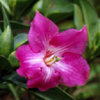SEARCH the
Gentian Research Network
and Rutgers University:
GENTIANS
Classification (newest)
List of genera
List by tribe
Gentian characteristics
Gentianales
RESEARCH
Research projects
People, addresses
Literature, publications
Links
Add info to
this site
TOPICS
Anatomy
Common names
Ecology - Natural history
GEOGRAPHY
Floras
Latin America
North America
TRIBES
Saccifolieae
_____________________
Information in other languages:
_____________________
This page
is maintained
by Dr.
Lena
Struwe
(e-mail),
and hosted by
Rutgers University, USA
updated: 01/19/11
| Anatomy
and other less visible characters of gentians
(Palynology, phytochemistry, karyology) |
 |
|||||||||||||||||||||||||||||||||||||||||||||||||||||||||||||||||||||||||||||||
|
Gentians are very variable in their anatomy and other characters. Listed below are some traits that occur in the family and their occurrence in investigated genera. Bibliographic references are listed in parenthesis [...] after the characters. See also the morphology page.
General anatomy [Perrot, 1897]:
Wood anatomy [Carlquist, 1986; Carlquist & Grant, 2005; Mennega, 1980; Perrot, 1897]:
Flower and fruit anatomy (see also Morphology) [Lindsey, 1940; Padmanabhan et al., 1978; Perrot, 1897; Struwe et al., 1997]:
Palynology
[Ho et al., 1994; Nilsson, 1968, 1970, 2002; Punt, 1978, 1980; Punt
& Nienhuis, 1976]
Seed anatomy (see also Seeds) [Bouman et al., 2002; Grothe & Maas, 1984]:
Embryology [Bouman et al., 2002; Maheswari Devi, 1962; Padmanabhan et al., 1978]:
Chromosome numbers:
Phytochemistry [Jensen & Schripsema et al., 2002]:
See
morphology page for Morphology Bisset, N. G. 1980a. Phytochemistry. Pp. 211-233. In: A. J. M. Leeuwenberg, editor. Engler and Prantl’s Die natürlichen Pflanzenfamilien, Angiospermae: Ordnung Gentianales, Fam. Loganiaceae, vol. 28b (1). Duncker and Humblot, Berlin. Bouman, F., L. Cobb, N. Devente, V. Goethals, P. J. M. Maas, & E. Smets. 2002. The seeds of Gentianaceae. Pp. 498-572. In: L. Struwe & V. A. Albert, editors. Gentianaceae – systematics and natural history. Cambridge University Press, Cambridge. Carpenter, I., H. D. Locksley, & F. Scheinmann. 1969. Xanthones in higher plants: biogenetic proposals and a chemotaxonomic survey. Phytochemistry 8: 2013-2026. Carlquist, S. & J. R. Grant. 2005. Wood anatomy of Gentianaceae, tribe Helieae, in relation to ecology, habit, systematics, and sample diameter. Brittonia 57(3): 276-291. Daniel, M. & S. D. Sabnis. 1978. Chemical systematics of family Gentianaceae. Curr. Sci. 47: 109-111. Grothe, E. H. M. & P. J. M. Maas. 1984. A scanning electron microscopic study of the seed coat structure of Curtia Chamisso & Schlechtendahl and Hockinia Gardner (Gentianaceae). Proc. Kon. Ned. Akad. Wetensch., Ser. C, 87 (1): 33-42. Jansen, S. & E. Smets. 1998. Vestured pits in some woody Gentianaceae. IAWA Journal 19: 35-42. Jansen, S. & E. Smets. 2000. Morphology, distribution, and systematic importance of vestures in the Gentianales. In: Nordenstam, B., El-Ghazaly, G. & M. Kassas (eds.) Plant systematics for the 21st century: 277-296, 25 figs. Wenner-Gren International Series Volume 77, Portland Press, London. XIII-366 p. ISBN 1 85578 135 2 Jensen, S. R. & J. Shripsema. 2002. Chemotaxonomy and pharmacology of Gentianaceae. Pp. 573- 632. In: L. Struwe & V. A. Albert, editors. Gentianaceae – systematics and natural history. Cambridge University Press, Cambridge. Maguire, B. & J. M. Pires. 1978. Saccifoliaceae – a new monotypic family of the Gentianales. Pp. 230-245. In: B. Maguire & collaborators, editors. The Botany of the Guayana Highland – Part X. Mem. New York Bot. Gard. 29. Marloth, R. 1909. A diplostigmatic plant, Sebaea exacoides (L.) Schinz (Belmontia cordata L.). Trans. Roy. Soc. South Africa 1(1): 311-314. Meszáros, S. 1994. Evolutionary significance of xanthones in Gentianaceae: a reappraisal. Biochem. Syst. Ecol. 22: 85-94. Nilsson, S. 1964. On the pollen morphology in Lomatogonium A. Br. Grana Palynol. 5: 298-329. Nilsson, S. 1967a. Pollen morphological studies in the Gentianaceae-Gentianinae. Grana Palynol. 7: 46-145. Nilsson, S. 1967b. Notes on pollen morphological variation in Gentianaceae-Gentianinae. Pollen Spores 9: 49-58. Nilsson, S. 1968. Pollen morphology in the genus Macrocarpaea (Gentianaceae) and its taxonomical significance. Sv. Bot. Tidskrift 62: 338-364. Nilsson, S. 1970. Pollen morphological contributions to the taxonomy of Lisianthus L. s. lat. (Gentianaceae). Sv. Bot. Tidskrift 64: 1-43. Nilsson, S. 2002. Gentianaceae – a review of palynology. Pp. 377-497. In: L. Struwe & V. A. Albert, editors. Gentianaceae – systematics and natural history. Cambridge University Press, Cambridge. Nilsson, S. & J. J. Skvarla. 1969. Pollen morphology of saprophytic taxa in the Padmanabhan, D., D. Regupathy, & S. Pushpa Veni. 1978. Gynoecial ontogeny in Enicostemma littorale Blume. Proc. Indian Acad. Sci. 87 B (Pl. Sci.-2, no. 5): 83-92. Perrot, M. E. 1897 [1899]. Anatomie comparée des Gentianacés. Ann. Sci. Nat. Bot. Ser. 8, 7: 105-292. Post, D. M. 1958. Studies in Gentianaceae. I. Nodal anatomy of Frasera and Swertia perennis. Botanical Gazette. 120(1):1-14. Punt, W. 1978. Evolutionary trends in the Potalieae (Loganiaceae). Rev. Palaeobot. Palynol. 26: 313-335. [Anthocleista, Fagraea, Potalia] Punt, W. 1980. Pollen morphology. Pp. 162-191. In: A. J. M. Leeuwenberg, editor. Engler and Prantl’s Die natürlichen Pflanzenfamilien, ANGIOSPERMAE: Ordnung Gentianales, Fam. Loganiaceae, vol. 28b(1). Duncker and Humblot, Berlin. [Anthocleista, Fagraea, Potalia] Punt, W. & P. W. Leenhouts. 1967. Pollen morphology and taxonomy in the Loganiaceae. Grana Palynol. 7: 469-516. [Anthocleista, Fagraea, Potalia] Punt, W. & W. Nienhuis. 1976. The northwest European pollen flora. 6. Gentianaceae. Rev. Palaeobot. Palynol. 21: NEPF 89-123. Rezende, C. M. A. D. M. & O. R. Gottlieb. 1973. Xanthones as systematic markers. Biochem. Syst. 1: 111-118. Struwe, L., J. W. Kadereit, J. Klackenberg, S. Nilsson, M. Thiv, K. B. von Hagen, & V. A. Albert. 2002. Systematics, character evolution, and biogeography of Gentianaceae, including a new tribal and subtribal classification. Pp. 21-309. In: L. Struwe & V. A. Albert (eds.), Gentianaceae: Systematics and Natural History, Cambridge University Press, Cambridge. Vinckier, S. & E. Smets. 2003. Morphological and ultrastructural diversity of orbicules in Gentianaceae. Annals of Botany 92: 657-672. Woodson, R. E. 1938. Observations on the floral fibres of certain Gentianaceae. Ann. Bot. (London) 50: 759-766.
© Lena Struwe, 2002-2004. |
||||||||||||||||||||||||||||||||||||||||||||||||||||||||||||||||||||||||||||||||

